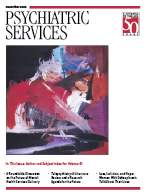A Focus Group Pilot Study of Tobacco Smoking Among Psychosocial Rehabilitation Clients
Abstract
OBJECTIVE: The study explored the perceived advantages and disadvantages of tobacco smoking and quitting among clients in psychosocial rehabilitation programs. Deeper understanding of such perceptions may be useful in creating maximally effective cessation and prevention interventions for this population. METHODS: Five focus groups of six to ten persons were formed with a total of 40 clients from two programs. Participants included smokers and nonsmokers—including former smokers and smokers who explicitly were not interested in quitting smoking. The semistructured, researcher-facilitated discussions covered pros and cons of smoking and not smoking, barriers to and facilitators of abstinence, and other issues. Audiotapes of the group discussions were transcribed and analyzed qualitatively. RESULTS: Participants emphasized their reasons for smoking, reasons for quitting or wanting to quit, views on smoking-related health concerns, perceived social costs and benefits of smoking, and strategies for quitting and maintaining abstinence. Many similarities between the focus groups' views and those of the general population were noted, along with some issues that are specific to having a mental illness or attending a psychosocial rehabilitation program, such as coping with psychiatric symptoms and limited access to information, support, and other coping methods. All of these views influenced participants' motivations and perceived readiness to smoke or to abstain, or to struggle between the two alternatives. CONCLUSIONS: Issues and needs that are specific to smokers who use mental health services must be addressed in the development of smoking prevention and cessation interventions in psychosocial rehabilitation and other mental health programs. The importance of messages about smoking that clients receive from program rules, program staff, and other sources is highlighted, as is the possibility that the regulation of affect and stress provided by tobacco use is especially important for people experiencing psychiatric symptoms.



